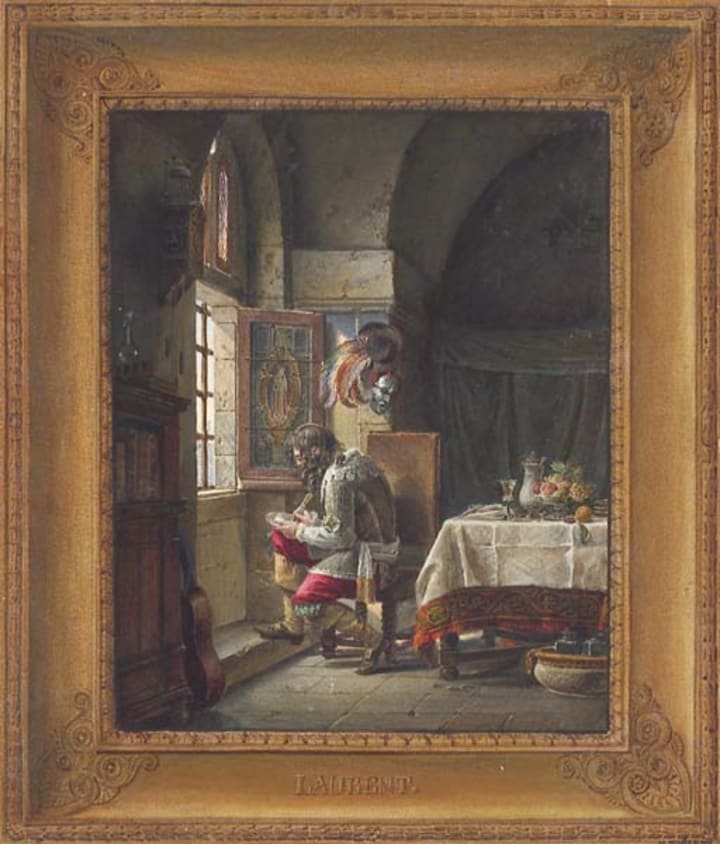The Man in the Iron Mask
Imprisoned for life. His identity guarded. His crime unknown. Who was the “Man in the Iron Mask”?

In 1698, a masked man is escorted from the prison fort on Île Sainte Marguerite, a small island to the south of France. Guards stand armed and ready, carefully watching him to ensure he does not attempt to escape or remove his mask, just as they have done for the past 11 years. This is nothing new for the masked man. This is the third prison he has called home over the past 29 years of his life.
Unfortunately for him, the fortress Bastille in Paris is his destination, where he will spend the rest of his life.

To this day, little is known about our mysterious masked man. We don’t know his true identity, and more importantly, we do not know his crime. The rumors and theories surrounding him have grown through time, overshadowing the facts we have found from historical records.
Centuries of legends and myths have left us with the mysterious moniker: “The Man in the Iron Mask”.
Historians, the general public, authors, philosophers, and even Hollywood have speculated what the true story is, and over time, facts and myths have merged, creating a messy hodge podge of information that is difficult to sift through for truth.
So, what do we know for sure?
Time Imprisoned
We know that the man was arrested in 1669, under French King Louis XIV’s orders, and began serving his sentence in Pignerol, Italy. He was kept under close watch of prison governor Bénigne d’Auvergne de Saint-Mars. His orders to keep this man confined and his identity a secret were so strict, that upon transferring to different prison assignments, Saint-Mars brough the masked man with him. A Lieutenant at the Bastille kept a record during his time there, and in 1968 he recorded that a new governor arrived with a long-time prisoner: a masked man whose name wasn’t given.
Over a 34-year window, the man was imprisoned in:
- Pignerol in northern Italy (1669 – 1681)
- The Fort of Exilles in northern Italy (1681 – 1687)
- Île Sainte Marguerite Fort in the south of France (1687 – 1698)
- The Bastille Bertaudière Tower in Paris (1698-1703)
Nameless and Faceless

We know that in all 34 years, there is no record of the man’s name, and there are no records of anyone seeing his face. Rumors differ on whether the man was forced to be masked 24/7, or only in the presence of others. We also know for sure that he was allowed very little human contact and was not allowed to speak of his identity.
Death
We know that the masked mans recorded death is November 19, 1703, in the Bastille. Upon his death, his existence was practically erased. His clothes, furniture, cell doors and windows were burnt. Any plates were melted, the walls were repainted, the ceiling replaced, and the floor was repaved.
Now, things get a bit messy, and we must turn to speculation.
The Mask
Despite the moniker “The Man in the Iron Mask”, it is very likely that the mask was not made of iron at all. It would have been much more common for the time for a velvet mask to have been worn. The Illustrated Magazine of Art in 1853 said that the mask was likely “black velvet, strengthened with whalebone, and fastened behind by a padlock.” Still uncomfortable, but better than iron, right?
Where did the idea of an “Iron Mask” come from then? Historians speculate that this was exaggerated by authors Voltaire and Alexandre Dumas as an iron mask has appeared in both of their works.
However, one tale states that during the Storming of the Bastille in 1789, a skeleton of a man wearing an iron mask was found chained in a hidden prison cell.
Treatment
We unfortunately have not determined with certainty how the man was treated during his 34 years of imprisonment.

Could the masked man have been treated well by his jailers?
We unfortunately have not determined with certainty how the man was treated during his 34 years of imprisonment.
Some say that the prisoner was treated well at first, before being given only what was needed to keep him alive. His mental state began to decline as he would rage and write on the walls with charcoal insults about King Louis XIV.
There are rumors that the masked man was always accompanied by two guards ready to shoot him if he were to take the mask off.

Other sources say that the guards treated him well and with respect, but not like royalty. He was even allowed to attend mass on holidays.
Two interesting legends exist, in regard to the lengths the guards went through to keep the prisoner’s identity a secret.
One tells us that the prisoner used a knife to etch his name onto a plate and threw it out a window. A passing fisherman found it and returned it to the guard. Upon being interrogated, he proved that he was illiterate and was allowed to go free.
Another story tells us that the prisoner wrote on one of his shirts and threw it out the window. A monk found it and returned it to the guard. Upon questioning, he swore that he had not read the writing on the shirt. Two days later, the monk was found dead in his bed. In yet another version, the monk was a barber passing by.
Based on all facts and rumors, we are only left with more questions than answers.
What was his crime?
What would be the purpose of keeping a prisoner’s identity so heavily guarded? And why keep him alive for so long? Surely it would have been easier to execute him based on the speculated severity of his crimes.
In James Perkins 1901 review of The Man in the Iron Mask by Tighe Hopkins, Perkins says “An extraordinary punishment must have owed its origin either to an extraordinary crime, or to a mystery that would be dangerous to the state if it became known.”
Despite how “extraordinary” this crime may have been, we have no record of it, and no explanation as to why the prisoner should have been kept alive for 34 years.
Who was the Man in the Iron Mask?
“Numerous theories have been put forward, all with some semblance of probability, yet all unsatisfactory.” The Illustrated Magazine of Art
Rumors about the masked man’s identity have been spread since soon after he arrived at the Bastille and have only gained momentum since his death.

Some popular but unlikely theories speculate that the masked man was:
- Louis XIV’s identical twin brother
- Louis XIV’s half brother
- Louis XIV’s illegitimate son
- Illegitimate son or daughter of the queen mother
- French playwright Molière
- A failed assassin
As exciting and juicy as those theories are, historians have narrowed down the masked man’s identity to two potential suspects.
Mattioli
Mattioli (sometimes referred to as Matthioli or Matthiole) born in 1640, was an Italian diplomat (a Count, an emissary, an Italian Secretary of State, or Italian Minister) that served Charles IV Duke of Mantua Italy. The theory states that Mattioli betrayed or double-crossed King Louis XIV, and as a subject of a foreign ruler, his imprisonment could have violated international law, so he had to be punished while hiding his identity.
Whatever his betrayal may have been, was enough to anger the King so much that he was imprisoned for life. The Illustrated Magazine of Art said “Louis, whether as a man or a sovereign, was one of the most cruel and tyrannical characters to be met with in the whole range of history”. That sure doesn’t sound like someone that would just let things slide.
The evidence supporting the theory that Mattioli is our masked man, was found in French government archives. Correspondence between French ministers of the time say that the prisoner is Italian and named Matthioli. Further, it said that Louis XV told Madame du Pompadour that the masked prisoner was an Italian minister, and Louis XVI told Marie Antoinette that it was a man from Mantua Italy.
Also, upon the masked man’s death, Saint-Mars had the name “Marchioly” listed in the parish records. That sounds a bit like Mattioli, doesn’t it? Plus, spelling was likely not standardized at the time.
The biggest hole in this theory, is that Mattioli died in 1694, which would be too soon for him to be the man in the mask. Unless the date of the masked man’s death were a lie to mislead those trying to determine his identity.
Eustache Dauger
Our other candidate is a man by the name of Eustace (sometimes Eustache) Dauger. He is believed to be a lowly valet that was involved in a political scandal at the time, but again, no one knows what he may have done.
There is evidence that Dauger was a prisoner that was with Saint-Mars through all his prison assignments. The Secretary of State wrote a letter to Governor Saint-Mars instructing him of the level of secrecy that must be maintained for Dauger upon transferring him to prison. This puts him in the correct prisons, at the correct time, with the level of secrecy we are looking for.
However, if Dauger was a lowly valet, then why would all the secrecy be needed? He isn’t famous or a diplomat that people may recognize, so it doesn’t make sense why we would need to conceal him to such an extent. Also, why not just kill him if he is not politically significant in some way.
Where does this leave us?
Just as confused as people were when questioning this at the time the masked man arrived at the Bastille.

Despite the numerous theories, evidence historians have sifted through, and centuries of speculation, we have no way of knowing with certainty who the Man in the Iron Mask was or what crime he committed to warrant such a punishment. Nearly 320 years since the masked man’s death, we may never solve this mystery.
Resources
Andrews, E. (2015, May 27). Who was the man in the iron mask? History.com. https://www.history.com/news/who-was-the-man-in-the-iron-mask
Perkins, James Breck. The American Historical Review, vol. 7, no. 1, 1901, pp. 136–38. JSTOR, https://doi.org/10.2307/1832545
Staff, S. D. (2020, July 28). Who was the “Man in the iron mask”? The Straight Dope. https://www.straightdope.com/21343200/who-was-the-man-in-the-iron-mask
“Matthioli: The Iron Mask.” The Illustrated Magazine of Art, vol. 2, no. 10, 1853, pp. 222–23. JSTOR, http://www.jstor.org/stable/20538126
About the Creator
Jen Mouzon
Sometimes truth is scarier than fiction. Obsessed with exploring and sharing myths, legends, weird history and the unexplained. Join me at hungryforlore.com.






Comments
There are no comments for this story
Be the first to respond and start the conversation.